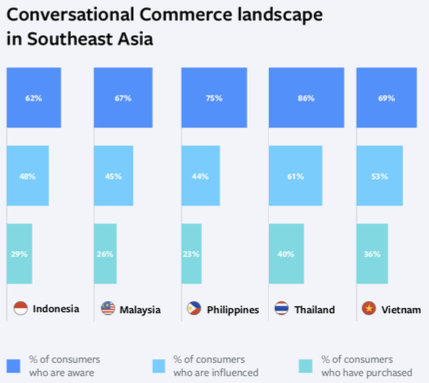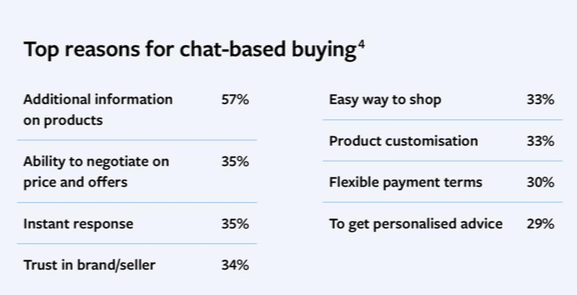
Southeast Asia has emerged as a leader in conversational commerce with high awareness and adoption of chat to buy and sell, says a new study.
The awareness about conversational commerce is the highest across Southeast Asia (72 per cent) compared to other countries (49 per cent), says a global study by Facebook and Boston Consulting Group.
For the uninitiated, conversational commerce is a dynamic consumer behaviour involving ‘conversational influence’ and ‘conversational influence’. Conversational influence is the process of having an online chat with a brand or seller in the lead-up to purchase or post-sale. Conversational transaction, on the other hand, means buyers place or confirm a final order with a brand or seller over social messaging applications or over chat on e-commerce platforms.
As per this study, 94 per cent of people surveyed said they planned to maintain or increase their conversational commerce spending in the future.

Facebook and Boston Consulting Group surveyed 8,864 people across nine countries and conducted qualitative interviews with buyers, sellers and experts around these countries. The study was conducted between May and August 2019. There were 5,391 respondents from Southeast Asia.
Southeast Asia outpaces other countries surveyed in both awareness and adoption of conversational commerce. Of the nine countries surveyed, the percentage of respondents who had undertaken a conversational commerce transaction was the highest in Thailand and Vietnam, at 40 per cent and 36 per cent, respectively, followed by Indonesia (29 per cent), Malaysia (26 per cent) and the Philippines (23 per cent).
The rate of adoption for other countries is still nascent — the US (5 per cent), Mexico (6 per cent), India (10 per cent), and Brazil (11 per cent).
Southeast Asian online shoppers were also much more likely to bypass traditional e-commerce opportunities in favour of chat. Nearly 45 per cent of the shoppers in the region said conversational commerce had driven their first online purchase as compared to 27 per cent of shoppers in the US.
“What’s truly astonishing is how just how quickly conversational commerce is transforming the global digital commerce landscape,” said Shiv Choudhry, MD and Partner of Boston Consulting Group and Leader of the Consumer and Retail Practice Group in Southeast Asia.

“Southeast Asia is currently experiencing rapid adoption rates, closely mirroring the evolution in China, where established e-commerce players are taking significant steps to adapt to this emerging market potential,” he added.
The study indicates that conversational commerce has a powerful advantage over traditional e-commerce modalities as it provides an instant way for people to find out more about a desired product or service.
Also Read: 2019: A hell of a year for marketers with chat and voice bots
Social media is the primary point-of-entry to conversational commerce with 69 per cent of shoppers across Southeast Asia crediting their discovery of conversational commerce to a social media post, link or advertisement in their feed. Approximately 47 per cent said they conduct conversational commerce on social media or messaging platforms, 44 per cent said they use e-commerce platforms, and nine per cent said they use brand websites.
The middle-aged women living in a middle-income household within cities are more likely to be conversational commerce users. The exception to this is Malaysia, where users are amongst younger shoppers and those and in Vietnam, where there are more users from the older age groups.

Conversational commerce cuts across categories, and people show a higher preference for a chat when buying clothes (67 per cent), food delivery (36 per cent) and footwear (32 per cent).
In terms of payment modes, the study shows that in Southeast Asia, cash-on-delivery and bank transfers are the most favoured methods of payment, except for Malaysia, where credit cards and bank transfers are preferred.
Image Credit: 123RF
The post Southeast Asia emerges as leader in conversational commerce; Thailand, Vietnam most advanced in adoption appeared first on e27.